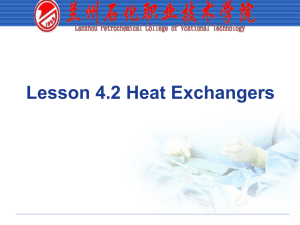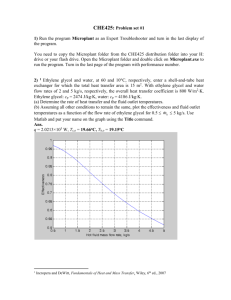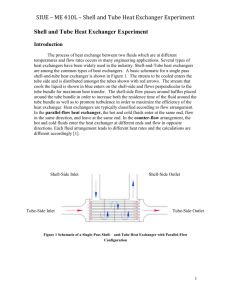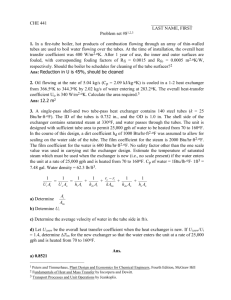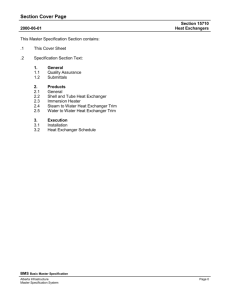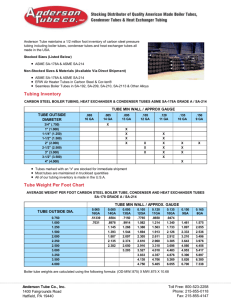EXPERIMENT NO: H6 Heat Transfer in a Shell and Tube Heat
advertisement
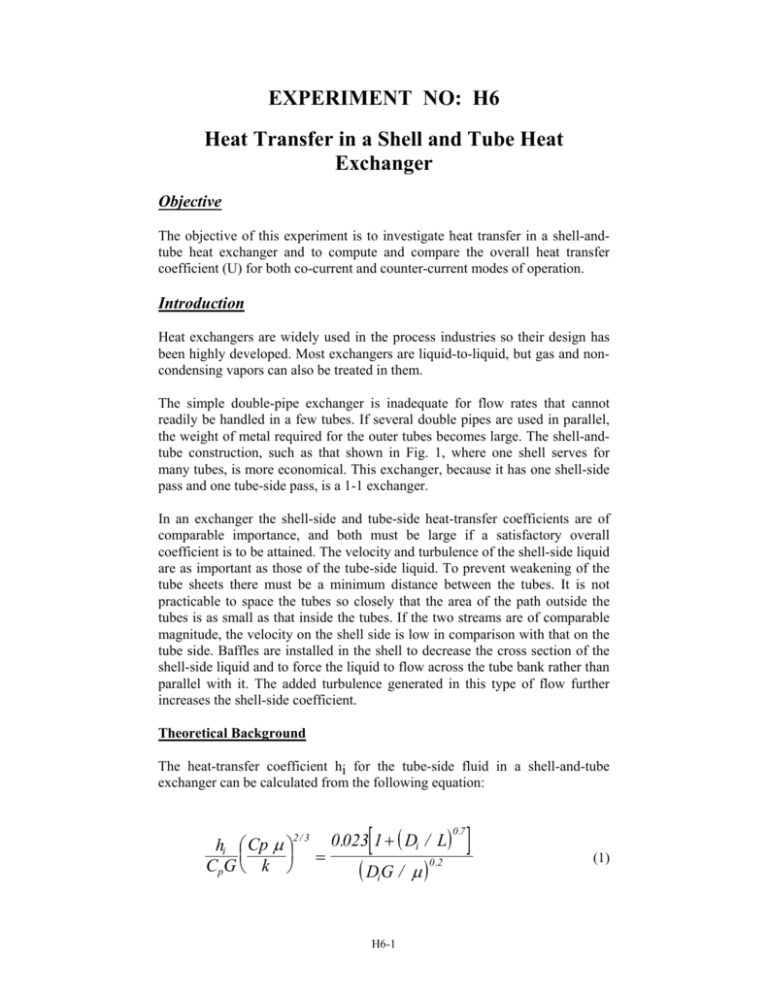
EXPERIMENT NO: H6
Heat Transfer in a Shell and Tube Heat
Exchanger
Objective
The objective of this experiment is to investigate heat transfer in a shell-andtube heat exchanger and to compute and compare the overall heat transfer
coefficient (U) for both co-current and counter-current modes of operation.
Introduction
Heat exchangers are widely used in the process industries so their design has
been highly developed. Most exchangers are liquid-to-liquid, but gas and noncondensing vapors can also be treated in them.
The simple double-pipe exchanger is inadequate for flow rates that cannot
readily be handled in a few tubes. If several double pipes are used in parallel,
the weight of metal required for the outer tubes becomes large. The shell-andtube construction, such as that shown in Fig. 1, where one shell serves for
many tubes, is more economical. This exchanger, because it has one shell-side
pass and one tube-side pass, is a 1-1 exchanger.
In an exchanger the shell-side and tube-side heat-transfer coefficients are of
comparable importance, and both must be large if a satisfactory overall
coefficient is to be attained. The velocity and turbulence of the shell-side liquid
are as important as those of the tube-side liquid. To prevent weakening of the
tube sheets there must be a minimum distance between the tubes. It is not
practicable to space the tubes so closely that the area of the path outside the
tubes is as small as that inside the tubes. If the two streams are of comparable
magnitude, the velocity on the shell side is low in comparison with that on the
tube side. Baffles are installed in the shell to decrease the cross section of the
shell-side liquid and to force the liquid to flow across the tube bank rather than
parallel with it. The added turbulence generated in this type of flow further
increases the shell-side coefficient.
Theoretical Background
The heat-transfer coefficient hi for the tube-side fluid in a shell-and-tube
exchanger can be calculated from the following equation:
hi ⎛ Cp μ ⎞
⎟
⎜
CpG ⎝ k ⎠
2/ 3
=
[
0 .023 1 + ( Di / L)
( DiG / μ )
H6-1
0 .2
0 .7
]
(1)
The viscosity correction term is omitted in the above equation as well as in all
equations that follow since the temperature difference is not much. In this
equation the physical properties of the fluid, are evaluated at the bulk
temperature.
The coefficient for the shell-side ho cannot be so calculated because the
direction of flow is partly parallel to the tubes and partly across them and
because the cross-sectional area of the stream and the mass velocity of the
stream vary as the fluid crosses the tube bundle back and forth across the shell.
Also, leakage between baffles and shell and between baffles and tubes shortcircuits some of the shell-side liquid and reduces the effectiveness of the
exchanger. An approximate but generally useful equation for predicting shellside coefficients is the Donohue equation (5), which is based on a weighted
average mass velocity Ge of the fluid flowing parallel with the tubes and that
flowing across the tubes. The mass velocity Gb parallel with the tubes is the
mass flow rate divided by the free area for flow in the baffle window Sb. (The
baffle window is the portion of the shell cross section not occupied by the
baffle). This area is the total area of the baffle window less the area occupied
by the tubes, or
π Do2
π Ds2
Sb = fb
− Nb
4
4
where
(2)
fb =
fraction of the cross-sectional area of shell occupied by baffle
window
Ds =
inside diameter of shell
Nb = number of tubes in baffle window
Do = outside diameter of tubes
In crossflow the mass velocity passes through a local maximum each time the
fluid passes a row of tubes. For correlating purposes the mass velocity Gc for
cross-flow is based on the area Sc for transverse flow between the tubes in the
row at or closest to the centerline of the exchanger. In a large exchanger Sc can
be estimated from the equation
⎛ D ⎞
Sc = PDs⎜1 − o ⎟
p⎠
⎝
where
(3)
p = center-to-center distance between tubes (1.65 cm)
P=
baffle spacing (15 cm)
The mass velocities are then
H6-2
.
Gb =
.
mc
mc
and Gc =
Sb
Sc
(4)
The Donohue equation is
0.6
ho Do
⎛ Do Ge ⎞ ⎛ Cp μ ⎞
⎟ ⎜
⎟
= 0.2⎜
k
⎝ μ ⎠ ⎝ k ⎠
0.33
(5)
where Ge = Gb Gc . This equation tends to give conservatively low values
of ho, especially at low Reynolds numbers. More elaborate methods of
estimating shell-side coefficients are available for the specialist. In j - factor
form Eq. (5) becomes
ho ⎛ Cp μ ⎞
⎟
⎜
CpGe ⎝ k ⎠
2/ 3
−0.4
⎛D G ⎞
= jo = 0.2⎜ o e ⎟
⎝ μ ⎠
(6)
Correction of LMTD for cross flow
If a fluid flows perpendicularly to a heated or cooled tube bank, the LMTD, as
given by the equation
ΔTL M =
ΔT2 − ΔT1
ln( ΔT2 / ΔT1)
(7)
applies only if the temperature of one of the fluids is constant. If the
temperatures of both fluids change, the temperature conditions do not
correspond to either countercurrent or parallel flow but to a type of flow called
cross flow.
When flow types other than countercurrent or parallel appear, it is customary
to define a correction factor FG, which is so determined that when it is
multiplied by the LMTD for countercurrent flow, the product is the true
average temperature drop. Figure 2 shows a correlation for FG for crossflow
derived on the assumption that neither stream mixes with itself during flow
through the exchanger. FG = 1 for 1-1 heat exchanger.
Each curved line in the figure corresponds to a constant value of the
dimensionless ratio Z, defined as
Z=
T4 − T5
T3 − T1
and the abscissas are values of the dimensionless ratio η H , defined as:
H6-3
(8)
ηH =
T3 − T1
T4 − T1
(9)
The factor Z is the ratio of the fall in temperature of the hot fluid to the rise in
temperature of the cold fluid. The factor ηH is the heating effectiveness, or the
ratio of the actual temperature rise of the cold fluid to the maximum possible
temperature rise obtainable if the warm-end approach were zero (based on
countercurrent flow). From the numerical values of ηH and Z the factor FG is
read from Fig. 2, interpolating between lines of constant Z where necessary,
and multiplied by the LMTD for counterflow to give the true mean temperature
drop.
The true mean temperature drop will be used in the following equation to
obtain overall heat transfer coefficient, U.
q = UAΔ TLM
U=
1
A ( ln{Do / Di }) 1
Ao
+ o
+ + Ro + Ri
Ai hi
2 π k gl L
ho
(10)
(11)
Note: Ro ≅ Ri = 3.0 * 10-4 m2 oC w-1 .
where q could be calculated from the following equation which is applicable to
both hot and cold fluids.
q = m( Hb − Ha )
(12)
Ha, Hb = enthalpies per unit mass of stream at entrance and exit, respectively.
Description of Equipment
The test unit consists of a graphite heat exchanger and a shell-and-tube heat
exchanger. A schematic sketch showing valves, pressure gauges, rotameters,
and the location of temperature sensors is given in Figure 1. The hot water,
produced by the graphite heat exchanger using steam, is on the tube side. The
cold water on the shell side can be directed co-current or counter-current to the
hot water. Opening hand valve HV-3 while closing HV-6 and HV-7 will
implement the counter -current mode of operation. Reversing each valve
position will implement the co-current mode.
The length of the test section is 1 m with 37 tubes each of outside diameter
1.15 cm and of 1 mm thickness. The shell side has 4 baffles, each occupies
50% of its cross-sectional area, distanced 15 cm from each other. The inside
diameter of the shell side is 15 cm.
H6-4
A set of 6 thermocouples is provided to record pertinent process temperatures.
A selector switch and digital read-out are provided. The temperature indicators
shown in Figure 1 will measure the following temperatures.
T1
cold water inlet temperature
T2
hot water outlet temperature for the graphite heat exchanger
T3
cold water outlet temperature for shell and tube heat exchanger.
T4
hot water inlet temperature for the shell and tube heat exchanger
T5
hot water outlet temperature, for the shell and tube heat exchanger
T6
Steam temperature
Cold water is supplied through a rotameter with a range of 0 - 1.2 CFM. Note
the wedge at the side of the rotameter must be used to read the flow rate. Flows
are controlled through manual control valves upstream of the rotameters (HV-1
for hot water feed to the shell-and-tube heat exchanger, and HV-2 for that of
the cold water).
Experimental Procedure
i)
Keep HV-5 open all the time.
ii)
Open HV-1 slowly.
iii)
Open HV-8 slowly.
iv)
Adjust HV-1 and HV-8 such that T2 is approximately 50oC - 60oC;
note that T2 should not exceed 85oC.
v)
Choose the mode of operation in the shell and tube heat exchanger by
opening and closing the appropriate valves (start first in counter-current
mode, by opening HV-3 while closing HV-6 and HV-7).
vi)
For a fixed hot water flow rate measure the following for six different
cold water flow rates:
a)
cold water flow rate to the shell-and-tube heat exchanger
b) hot water flow rate to shell and tube heat exchanger via the
graphite heat exchanger
Three)
temperature
cold
d) cold water outlet temperature
H6-5
water
inlet
Five)
temperature
hot
water
inlet
Six) hot water outlet temperature
vii)
Repeat the experiment with co-current flow conditions instead of that
of the counter-current (i.e. by closing HV-3 while opening HV-6 and
HV-7), but keep the hot water flow rate unchanged.
Shut Down Procedure - Shell and Tube Heat Exchanger
i)
ii)
iii)
iv)
v)
Close HV-8
Close HV-1 and HV-2
Close HV-4
Close HV-3 and open HV-6
Leave the unit in a safe and clean condition
Experimental Program
A set of six measurements will be taken for each mode of operation. The cold
water flow rate will be varied in the range 6.1 - 23.1 Liter/min. The hot water
flow rate and temperature will stay approximately constant at about 12.6
Liter/min and 55oC, respectively. Since the cold water for both the graphite
and the shell-and-tube heat exchangers is obtained from the same water main,
the cold water to the graphite heat exchanger must be checked whenever the
cold water to the shell and tube heat exchanger flow rate is changed. A log
sheet suitable to record all experimental data is attached.
Data Analysis
The following items must be covered in the analysis:
1)
Carry out an energy balance for the tube-side and the shell side.
2)
Compute the experimental overall heat transfer coefficient for the heat
exchanger.
3)
Plot on a log-log scale the computed experimental overall heat transfer
coefficient vs the shell-side Reynolds’s number.
4)
Calculate the theoretical heat transfer coefficient and compare with the
experimental one.
H6-6
References:
Welty, J.R., Wicks, C.E., and Wilson, R.E., “Fundamentals of Momentum,
Heat and Mass Transfer”, 3rd edition, Wiley and Sons (1984)
Chapman, A.J., “Heat Transfer”, 4th edition, Macmillan Publishing Company
(1989)
Notation:
A
Area, (m2)
Cp
Specific heat at constant pressure, (kJ/kg.K)
D
Diameter, (m); De, equivalent diameter of noncircular channel; Di,
inside diameter of tube; Do, outside diameter of tube; Ds, inside
diameter of exchanger shell.
FG
Correction factor for average temperature difference in crossflow or
multipass exchangers, dimensionless
fb
Fraction of cross-sectional area of shell occupied by baffle window
(0.2)
G
Mass velocity, (kg/m2-s); Gb, in baffle window; Gc, in crossflow; Ge,
effective value in exchanger, Gb Gc .
h
Individual heat-transfer coefficient, (W/m2.K); hc, for outside of coil,
hi, for inside of tube; hj, for inner wall of jacket; ho for outside of tube
j
j factor dimensionless; jo, for shell-side heat transfer
kgl
Thermal conductivity, (W/m.K); km, of tube wall
k
Thermal conductivity, (W/m.K); km, of the fluid
m
Mass of liquid, (kg)
.
.
m
Flow rate, (kg/s); m c , of cooling fluid
Nb
Number of tubes in baffle window
P
Baffle pitch or spacing, (m)
p
Center-to-center distance between tubes, (m)
H6-7
Q
Quantity of heat, (J); Qr, total amount transferred during time interval tr
q
Rate of heat transfer, (W)
S
Cross-sectional area, (m2) ; Sb, area for flow in baffle window; Sc, area
for crossflow in exchanger shell
T
Temperature, (oC); at warm-fluid inlet; Thb, at warm-fluid outlet; Tr,
reduced temperature; Ts, temperature of
U
Overall heat-transfer coefficient, (W/m2.K); Ut, based on inside area
Z
Ratio of temperature ranges in crossflow or multipass exchanger,
dimensionless [Eq. (15-6).
H6-8
Date:___________
Log-Sheet for Shell and Tube H.C.(Expt #H6)
Hot water flowrate:_______________
Cocurrent
Run
No.
Cold
Flow
Lit/min
T1
T3
T4
T5
oC
oC
oC
oC
1
2
3
4
5
6
Counter-Current
Run
No.
Cold
Flow
Lit/min
T1
T3
T4
T5
oC
oC
oC
oC
1
2
3
4
5
6
H6-9
PI
T
HV
PI
PCV
T
FI
PCV
HV-8
Hand Valve
Pressure Indicator
Pressure Control Valve
Thermocouple
Flow Indicator - Rotameter
T5
Graphite Heat
Exchanger
T4
HV-5
T2
PI
PI
PI
HV-6
HV-7
PI
HV-3
FI
T3
T6
HV-1
T
Condensate
FI
PI
T1
PC
V
HV-2
Shell Drain
Tube Drain
HV-4
Figure 1: Schematic Diagram of Shell & Tube
Experiment
H6-10
